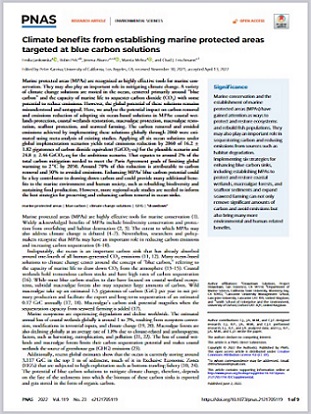
Marine protected areas (MPAs) are recognized as highly effective tools for marine conservation. They may also play an important role in mitigating climate change. A variety of climate change solutions are rooted in the ocean, centered primarily around “blue carbon” and the capacity of marine life to sequester carbon dioxide (CO2) with some potential to reduce emissions. However, the global potential of these solutions remains misunderstood and untapped. Here, we analyze the potential impact on carbon removal and emissions reduction of adopting six ocean-based solutions in MPAs: coastal wetlands protection, coastal wetlands restoration, macroalgae protection, macroalgae restoration, seafloor protection, and seaweed farming. The carbon removal and avoided emissions achieved by implementing these solutions globally through 2060 were estimated using meta-analysis of existing studies. Applying all six ocean solutions under global implementation scenarios yields total emissions reduction by 2060 of 16.2 ± 1.82 gigatonnes of carbon dioxide equivalent (GtCO2-eq) for the plausible scenario and 24.8 ± 2.46 GtCO2-eq for the ambitious scenario. That equates to around 2% of the total carbon mitigation needed to meet the Paris Agreement goals of limiting global warming to 2 °C by 2050. Around 70% of this reduction is attributable to carbon removal and 30% to avoided emissions. Enhancing MPAs’ blue carbon potential could be a key contributor to drawing down carbon and could provide many additional benefits to the marine environment and human society, such as rebuilding biodiversity and sustaining food production. However, more regional-scale studies are needed to inform the best strategies for preserving and enhancing carbon removal in ocean sinks.












